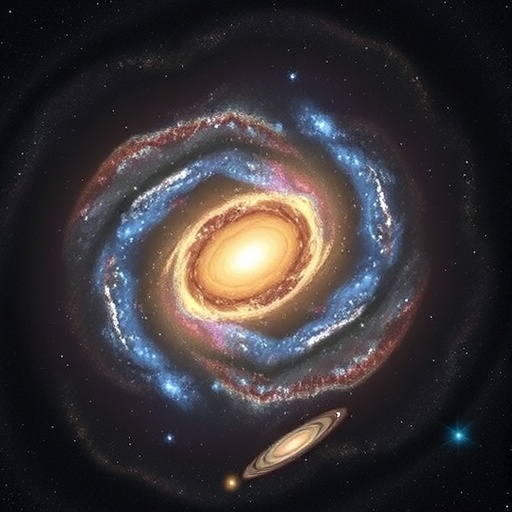In the vastness of our universe, the concept of satellites extends far beyond the familiar realms of moons orbiting planets or artificial satellites encircling Earth. Galaxies themselves can act as hosts, accompanied by smaller, gravitationally bound companions known as satellite galaxies. These celestial bodies, composed of stars, gas, dust, and dark matter, provide cosmic laboratories that offer profound insights into the mechanisms of galaxy formation, evolution, and the enigmatic nature of dark matter.
Traditionally, our understanding of satellite galaxies has been anchored in investigations centered on large galaxies akin to our own Milky Way. These host galaxies are massive, sprawling systems whose satellite populations have been cataloged and studied extensively, revealing correlations between host mass and satellite abundance. Yet, the satellite galaxy populations of dwarf galaxies—those minuscule cosmic islands with masses comprising only a fraction, often less than a tenth, of the Milky Way—have remained largely unexplored until now.
A pioneering study spearheaded by Dartmouth astronomers has dramatically expanded the frontier of satellite galaxy research by scrutinizing dwarf galaxies as hosts. This multi-institutional survey leaps forward by tripling the number of dwarf galaxies examined for potential satellites. Utilizing advanced image-processing techniques and extensive datasets, the astronomers have identified a staggering 355 candidate satellite galaxies. Notably, 264 of these candidates represent new discoveries, and among them, 134 hold a high likelihood of being bona fide satellites.
This leap in satellite detection owes much to sophisticated algorithms designed to mitigate the “noise” pervading astronomical images. Such noise includes the interference from background stars, overlapping light halos from bright sources, and various instrumental artifacts. By carefully cleaning and refining the data culled from the Dark Energy Spectroscopic Instrument (DESI) Legacy Imaging Surveys, the researchers succeeded in isolating faint satellite galaxy candidates otherwise obscured in crowded fields.
The implications of researching satellite galaxies around dwarf hosts are far-reaching. Dwarf satellites are among the smallest and faintest galaxies known, yet they are crucial for testing cosmological models, particularly concerning dark matter. Because these tiny galaxies are dominated by dark matter, they serve as near-pristine laboratories to probe the elusive substance’s properties. By understanding how dark matter structures and influences such environments, astronomers inch closer to unraveling one of the most profound mysteries in modern physics.
“The smallest galaxies provide us with the cleanest laboratory for understanding dark matter,” explains Burçin Mutlu-Pakdil, assistant professor of physics and astronomy at Dartmouth and a lead author of the study. She emphasizes that creating a statistically significant sample of these diminutive cosmic structures is essential for uncovering the fundamental physics guiding galaxy formation and evolution.
The study’s approach goes beyond mere enumeration. By analyzing how satellite galaxies cluster around hosts of varying sizes and in diverse cosmic neighborhoods, the researchers seek to decipher the influence of environmental factors on satellite formation. Compared to large galaxies like the Milky Way, which typically host numerous satellites, the probability and characteristics of satellites orbiting smaller dwarf galaxies may differ substantially, presenting challenges to current galaxy formation models.
Laura Hunter, a postdoctoral fellow at Dartmouth and the corresponding author of the study, highlights the uniqueness of astronomical research: “Astronomy does not allow controlled experiments. Instead, we rely on deep observation and comprehensive measurements. We then model these data numerically to see if our assumptions about the universe hold true. When the data conflict with predictions, we confront new physics or refine our theories.”
For their detailed search, the research team selected 36 dwarf host galaxies exhibiting a range of sizes and proximities to other galaxies to capture potential environmental variances. Their meticulous methodology involved an algorithmic cleaning of the observational data to suppress irrelevant signals, followed by painstaking visual inspections to exclude artifacts or spurious detections. This dual approach helped ensure that the satellite candidates identified are genuine astronomical objects rather than image anomalies.
This survey marks the advent of a new era in dwarf satellite galaxy research and sets the stage for subsequent investigations. The team is actively engaged in follow-up observations to confirm which candidates are authentic satellite galaxies. Beyond identification, these studies will explore physical attributes such as size, spatial distribution, and composition, including gas content and rates of star formation, which are pivotal for understanding galactic evolution.
Securing these answers will demand substantial telescope time and resources, but the anticipated scientific payoff is considerable. As Mutlu-Pakdil emphasizes, every satellite galaxy discovered serves as a key to unlocking the complex physics underpinning galaxy formation and the behavior of dark matter. Such insights not only enrich our knowledge of the universe’s structure but may also illuminate the conditions prevailing in its earliest epochs.
The implications of this research transcend mere cataloging. By bridging observational data with theoretical frameworks, the results could challenge or validate existing cosmological models, especially those concerning hierarchical galaxy formation and the role of dark matter halos. Understanding how satellite galaxy systems scale with host mass and environment has the potential to refine or redefine prevailing astrophysical conceptions.
In essence, this study amplifies our cosmic perspective by illuminating the smallest players on a grand stage. By peering into the shadows cast by dwarf galaxies, astronomers unlock clues embedded within the faint glow of their satellites, providing fresh windows into the universe’s formation, the distribution of dark matter, and the intricate dance of celestial structures across cosmic time.
Subject of Research: Not applicable
Article Title: Identifying Dwarfs of MC Analog GalaxiEs (ID-MAGE): The Search for Satellites Around Low-mass Hosts
News Publication Date: 5-Aug-2025
Web References:
References:
- Scientists affiliated with Dartmouth College, including Burçin Mutlu-Pakdil, Laura Hunter, Emmanuel Durodola, and Rowan Goebel-Bain
Image Credits: Photos by Laura Hunter
Keywords
Dwarf galaxies, Galaxies, Astronomy, Celestial bodies, Active galaxies, Galactic clusters, Peculiar galaxies, Celestial mechanics, Orbits, Observational astronomy, Outer space, Interstellar space, Astrophysics, Observational studies, Physics




